
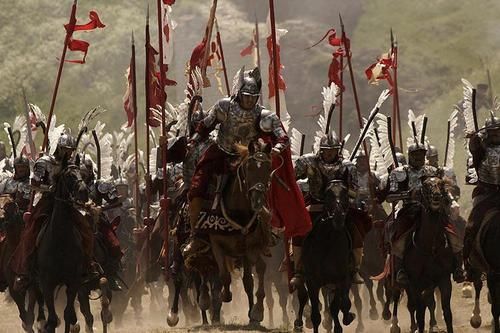
 Late last night I watched a very interesting series of videos about Winged hussars, their equipment and tactics. The videos were in Polish but I figured I could share what I learned in English, there were a couple of new things in the videos that aren't covered in the By Fire & Sword book - but which helped me understand and further appreciate some of the rules for weapons, and game play mechanics involved in that game!
Late last night I watched a very interesting series of videos about Winged hussars, their equipment and tactics. The videos were in Polish but I figured I could share what I learned in English, there were a couple of new things in the videos that aren't covered in the By Fire & Sword book - but which helped me understand and further appreciate some of the rules for weapons, and game play mechanics involved in that game!Winged Hussar armor
The armor was made up of a breastplate, shoulder guards, lobster helmet, bracers and sometimes armor protection on the upper part of the leg (this never extended below the knee).
The helmet had a nose guard which was mounted above the helmet prior to battle, but which was removed and attached reversely so that it protected the face during combat. The nose guard was held in place with a screw, and was small enough not to limit the vision, but big enough to protect the face from horizontal sword blows. The helmet brim also helped to increase the deflection of vertical sword blows.
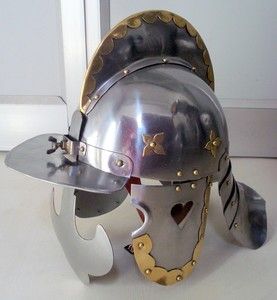 The breastplate was made out of several parts so that it could be worn comfortably when sitting atop a horse, especially at the lower part of the breastplate at the stomach area. The armor did generally not have a proper back plate but rather a smaller round metal plate(button) which (along with the shoulder armor and leather belts) served to protect the upper back. The back was also protected by animal skins, of common or exotic origin, and it served not only to appear more intimidating to the enemy but also added additional protection in close combat. The animal skin was quite difficult to cut through with sword blows ( a real animal skin such as that of a wolf was very thick and weighed around 10kg) , and as it rested atop the thick leather belts holding the breastplate and the round metal plate on the upper back it provided
The breastplate was made out of several parts so that it could be worn comfortably when sitting atop a horse, especially at the lower part of the breastplate at the stomach area. The armor did generally not have a proper back plate but rather a smaller round metal plate(button) which (along with the shoulder armor and leather belts) served to protect the upper back. The back was also protected by animal skins, of common or exotic origin, and it served not only to appear more intimidating to the enemy but also added additional protection in close combat. The animal skin was quite difficult to cut through with sword blows ( a real animal skin such as that of a wolf was very thick and weighed around 10kg) , and as it rested atop the thick leather belts holding the breastplate and the round metal plate on the upper back it provided  the Winged Hussar with ample protection.
the Winged Hussar with ample protection. Atop the breastplate the hussar also wore a gorget which protected the neck area and collar bones.
The metal parts of the full hussar armor including the helmet did not weigh more than 15kg. The thickness of the armor was about 3mm to the front and 1mm on the sides. The breastplate was bullet proof and required to pass a test with a gun at the blacksmith,
Slung over the shoulder was a metal case carrying paper tubes with pre measured amounts of gunpowder which were emptied in the pistols and other firearms the hussar would carry into battle, then from a smaller container the hussar added gunpowder for the flintlock. The effective range of a shot from a pistol was only about 5-6 meters.
 Winged hussar saber
Winged hussar saberThe Winged hussar saber was light but durable, reduction of the weight was made by making two channels in the blade. The grip came with a special guard for the thumb which not only served to protect the thumb from being cut off by a sword blow being deflected on the side of the hussar saber, but also made the grip of the sword itself tighter and reduced the risk of losing the sword in combat. The tight grip thus allowed for more fluid and advanced slashes and the sword did not turn or move around while being
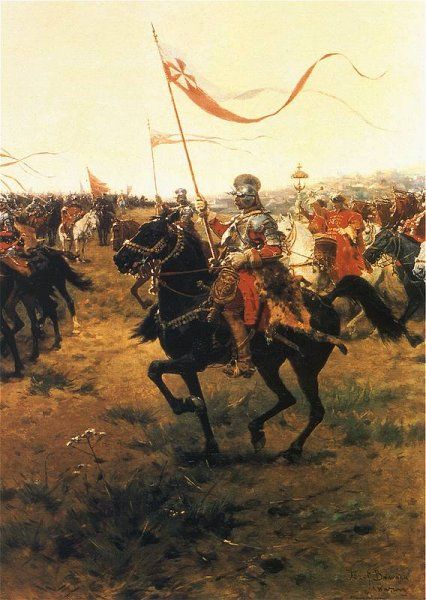 used and retained an effective angle at all times. If the saber lacked the thumb guard then the rider would wear a thick separate thumb guard.
used and retained an effective angle at all times. If the saber lacked the thumb guard then the rider would wear a thick separate thumb guard.The saber was mainly sharpened on one, but the top of the saber was also sharpened in the back which allowed for slashing both ways.
 Winged hussar lance and estoc
Winged hussar lance and estocThis was a roughly 5-6 meters long. At the tip of the lance was a pennant, which served to create a great noise when hussars charged at full speed in massed numbers. The noise from the pennants is what often is mistaken for the noise made by the wings, and was unnerving for the enemy awaiting to receive the charge.
Fastened to the saddle was a leather strap with which helped the hussar to hold and carry the lance, which though hollow was 5-6 meters long and weighed 3kg. The idea was that the hussar wasn't supposed to hold the lance in a tight grip during a charge ,but rather hold it lightly and aim it with the help of the leather strap - allowing the impetus and speed of the horse punch it into the enemy. The force from the impact of the lance did thus not hit the hussar arm but was transferred to the saddle preventing any potential arm injury of the rider. During battle it was common for the lance to impale at least two enemy infantrymen if they were standing in formation, more often than not even more were impaled by a single lance.
Once the lance had been broken from the impact it was discarded and the hussar drew his estoc which was a very long and heavy straight sword. This was used in the continuous charges and the length of this weapon was about 1.8 meters and good for punching through enemy armor. The sword was too heavy and unwieldy to be used like the saber, and was mainly used for thrusting enemy soldiers from above or when charging it was pointed at the enemy and again the saddle helped the hussar to absorb the force from the impact - the butt of the estoc was pressed against the front of the saddle. This weapon was used while the hussar horse galloped, and mainly served to impale enemy cavalry riding at the hussar from the opposite direction. This weapon was capable of puncturing any armor.
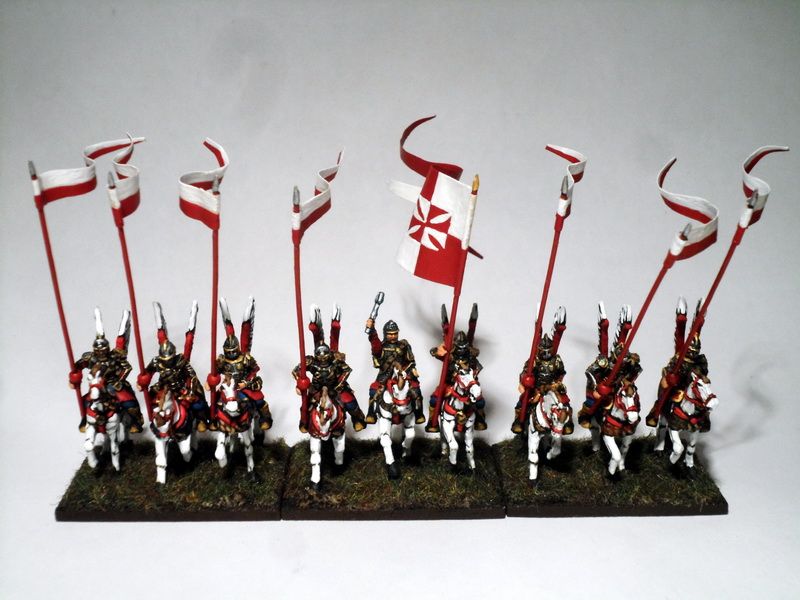
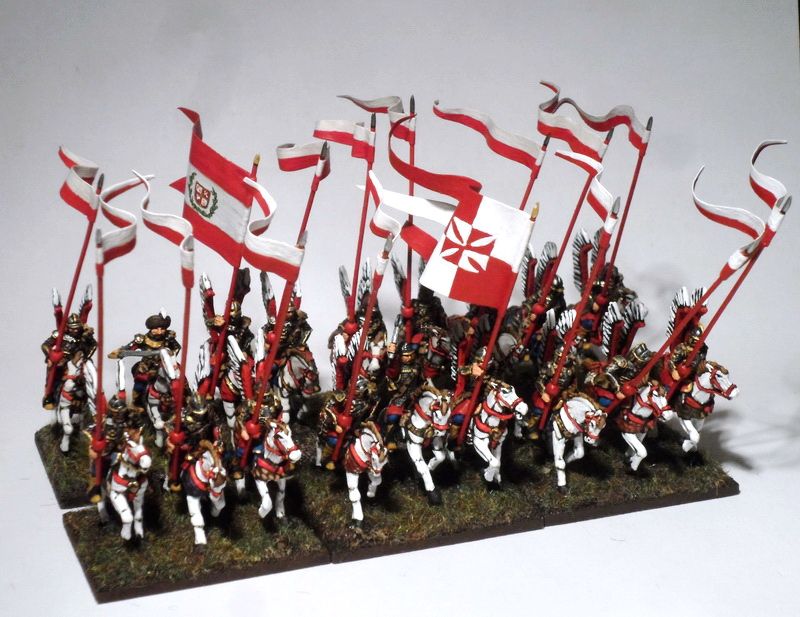
 Hussar wings
Hussar wingsThe wings of the hussar were always mounted to the back of the saddle, and it could either be a single wing or two. The wings were supposedly seldom worn into battle as they were in the way of mounting and dismounting the horse.
Hussar horses
These were not domestic but of pure blooded stock that had to be imported from Turkey or Araby. These horses were not very big but very fast and durable. However these horses matured rather late, and they stopped growing first at the age of 6, meaning most hussar horses were 7 years old before they were brought into battle. This meant that a horse such as this had to be fed and trained for 7 years, making it extremely expensive - the impressive price tag for one such horse equaled around 66kg of silver! However as the hussars were made up of nobility they could afford the cost and most hussars owned at least two horses, sometimes three or even four.
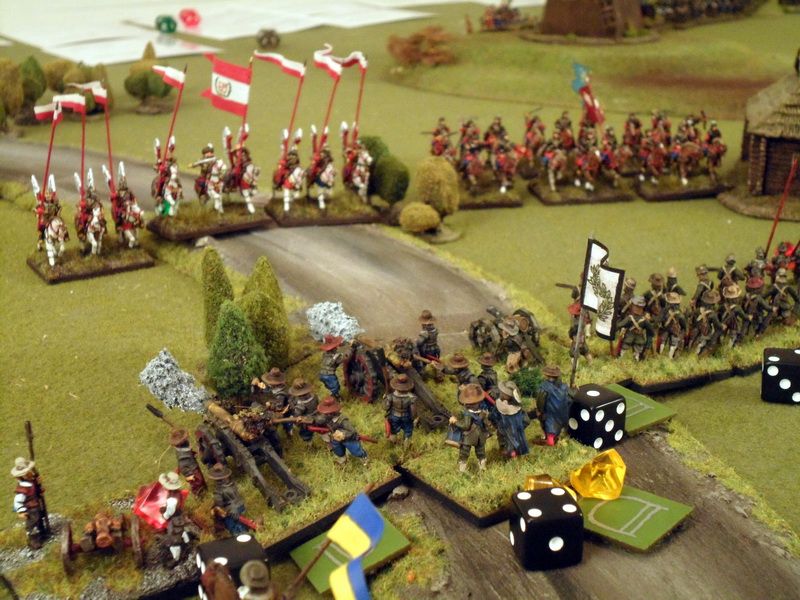 Among the training methods for the hussar horses was a small track, 1 meter wide and 25 meters long. At both ends of the track there were small 2.5meters in diameter round zones where the horse could turn around. During training the horse was raced back and forth, bringing it to a sudden halt and quickly turned around. This training made the hussar horses build up good condition and made them able to quickly perform turns and changes in direction during movement.
Among the training methods for the hussar horses was a small track, 1 meter wide and 25 meters long. At both ends of the track there were small 2.5meters in diameter round zones where the horse could turn around. During training the horse was raced back and forth, bringing it to a sudden halt and quickly turned around. This training made the hussar horses build up good condition and made them able to quickly perform turns and changes in direction during movement.The reason why a hussar needed more than one horse was simply because that horses often died in battle. Casualty ratio of riders was very low even in prolonged battles, estimated around 5% on a good day. However the horses often suffered 30% casualties.
An interesting fact is that horses at full gallop during a charge rarely stopped when hit by bullets. A horse hit by a bullet was already dying but the adrenaline and speed kept it going long enough to make the impact with the target - often infantry. This caused infantry to believe that the hussar horses were special and invincible during a charge as the horses of Reiters which either stood still or moved slowly quickly toppled over when hit by a musket. The impetus built up by a horse during a charge however had it last until impact.
Fighting infantry
The hussars fought all kinds of opponents, and adjusted their weaponry accordingly. Against tatar cavalry they did not use the lance but rather carbines and pistols. The main enemy was most often enemy infantry of Pike & Shot formations.
Enemy infantry during this period often had heavy muskets that rested on a musket fork during firing. Musketeers had to use "counter march" maneuvers to keep up a continuous rate of fire. A single musket took about 2 minutes to load, but with musketeers formed in several ranks they could cycle their ranks and fire one shot every 15-20 seconds. The weight of the musket made it hard if not impossible to fire salvos from several ranks at a time.
Oddly enough the main threat to winged hussars were not the pikemen but the musketeers themselves. The reason for this was that the winged hussar lance was longer than the pikes of pikemen during this period. More often than not the pikemen were hit before they hit the hussars charging at them, pikes during this period were often just above 3 meters long and as mentioned the hussar lance could be as long as 6 meters.
Instead most casualties came from getting gunned down durign the charge, but even this was hard for enemy infantry to do due to the weapons of the time which were highly inaccurate and ineffective at longer ranges. And while the musketeers fired their first rank the winged hussars had already closed in by around 60 meters which prevented a second line of musketeers to have time to move up and fire. Hussar charges performed at around 80 meters simply prevented enemy musketeers to efficiently use their counter march, and firing at longer ranges than 60-80 meters - something which would permit two lines to fire required was extremely ineffective. Lethality from musket fire was as such relatively low, added to the difficulty of hitting a moving target was the fact that hussars approached enemy formations in open order (only to close ranks just before the last stage of the charge).
As the hussars closed in on their enemy their ranks closed and accuracy from enemy weapons improved - but by that time the cavalry was seconds away from crashing into their opponents. Combat efficiency of hussar banners was also retained by the way they approached the enemy, doing so in lines where gaps were quickly filled by companions riding up from behind, if someone was killed or had his horse shot down from under him, in order to fill the gap.
.........
It is very interesting to see how much of this is represented in the rules of the game By Fire & Sword, both in terms of weapon profiles, special rules for infantry, movement abilities of cavalry and stats.
This makes you understand why infantry with lighter muskets able to perform a salvo where you fire with all muskets at the same time is a better option against such heavy cavalry as opposed of the heavy Spanish muskets that can only perform "counter march" (where you fire once in the defensive fire and once in the shooting after movement step).
It also gives you an idea of the reasoning behind rules such as "companions" for most of the Polish cavalry, "first strike" for hussar lances, the good armor value of the Winged hussars and why many of the Polish-Lithuanian cavalry units including the hussars have increased charge and pursuit range than that of Reiter formations.
No comments:
Post a Comment